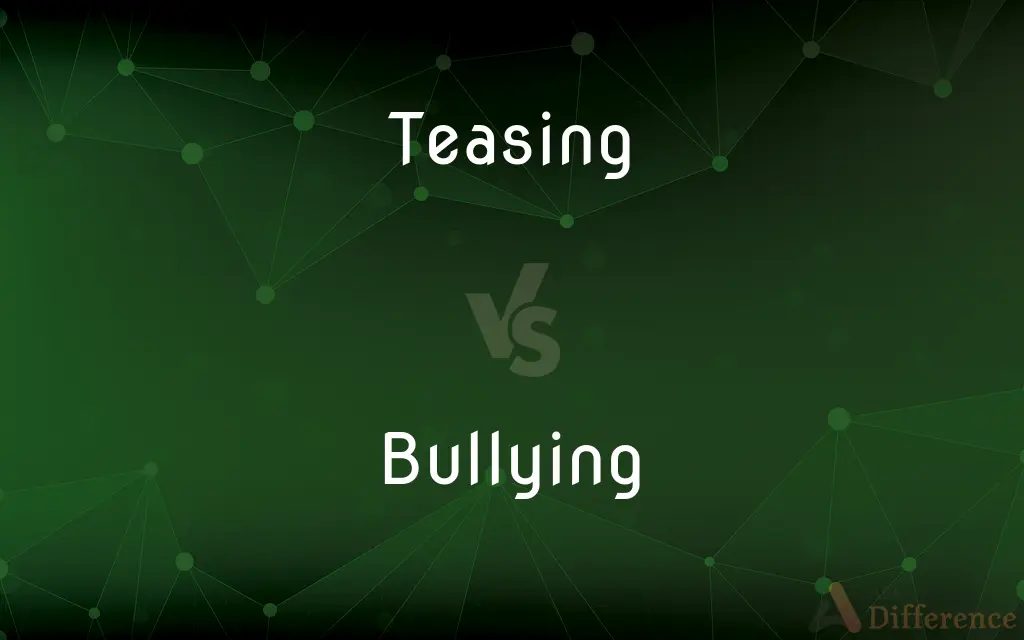Teasing vs. Bullying — What's the Difference?
By Fiza Rafique & Urooj Arif — Updated on March 9, 2024
Teasing involves playful or humorous remarks not meant to harm, while bullying is intentional, harmful behavior repeated over time.

Difference Between Teasing and Bullying
Table of Contents
ADVERTISEMENT
Key Differences
Teasing often serves as a means of social interaction, involving light-hearted, playful comments or jokes between individuals. It usually occurs among friends or acquaintances and is meant to be amusing without causing harm. Whereas, bullying represents a deliberate attempt to hurt, intimidate, or exert power over someone, typically characterized by repeated aggressive behavior. This can include physical, verbal, or psychological attacks aimed at causing distress or harm to the victim.
In the context of intent, teasing is often motivated by a desire to foster connection or humor in a relationship without the intention to cause pain or distress. It is generally understood and accepted by all parties involved. On the other hand, bullying is driven by an intent to harm, control, or dominate, often reflecting an imbalance of power between the bully and the victim. The behavior is unwanted and unprovoked, leading to feelings of fear, discomfort, or humiliation in the victim.
The reaction from the recipient also distinguishes these two behaviors. Teasing, when done in good nature, is usually met with laughter or a playful response from the recipient, who recognizes the teasing as non-threatening. However, bullying elicits feelings of distress, fear, or anger in the victim, often leading to long-term psychological effects, such as low self-esteem, anxiety, or depression.
The social dynamics surrounding teasing and bullying are also notably different. Teasing can serve as a bonding mechanism within a group, reinforcing social connections and camaraderie. In contrast, bullying often isolates the victim, creating an environment of fear and exclusion, which can disrupt the social fabric of a group or community.
Lastly, the consequences of each behavior vary significantly. Teasing, when mutual and light-hearted, generally does not have long-lasting negative effects and can sometimes enhance relationships through shared laughter. Bullying, however, can have severe and enduring impacts on the victim's mental and physical health, academic performance, and overall well-being, necessitating intervention and support.
ADVERTISEMENT
Comparison Chart
Intent
To amuse, without intending harm
To harm, intimidate, or exert power
Nature
Playful, light-hearted
Aggressive, harmful
Reception
Usually met with laughter or a playful response
Leads to distress, fear, or anger
Social Dynamics
Can foster connection and camaraderie
Creates isolation and disrupts social harmony
Consequences
Generally no long-lasting negative effects
Severe and enduring impacts on the victim
Compare with Definitions
Teasing
Light-hearted mocking or playful remarks.
She enjoyed teasing her brother about his quirky habits.
Bullying
Repeated aggressive behavior intended to hurt someone.
The bullying at school left him feeling isolated.
Teasing
Gentle provocation meant in fun.
Their teasing banter was a sign of their close friendship.
Bullying
Acts of intimidation or coercion.
She was a victim of verbal bullying for months.
Teasing
A form of social interaction among friends.
The playful teasing at the dinner table added to the evening's enjoyment.
Bullying
Deliberate exclusion or humiliation of someone.
Cyberbullying has become a serious issue among teenagers.
Teasing
A way to show affection or camaraderie.
The teammates' teasing showed their strong bond.
Bullying
Power imbalance exploited to harm others.
The older student's bullying of the younger ones created a toxic environment.
Teasing
An attempt to provoke a reaction in a playful manner.
His teasing about her cooking skills made her laugh.
Bullying
Repeated actions causing fear or distress.
The constant bullying affected her mental health.
Teasing
Teasing has multiple meanings and uses. In human interactions, teasing exists in three major forms: playful, hurtful, and educative.
Bullying
Bullying is the use of force, coercion, hurtful teasing or threat, to abuse, aggressively dominate or intimidate. The behavior is often repeated and habitual.
Teasing
To make fun of (someone) playfully or taunt annoyingly
Was teased by my classmates for being skinny.
Teased him about driving such a fast car.
Bullying
A person who is habitually cruel or overbearing, especially to smaller, weaker, less popular, or more vulnerable people.
Teasing
To say in a playful or mocking way
"But you're too young to get married," he teased.
Bullying
A hired ruffian; a thug.
Teasing
To provoke or irritate, as with physical movements
Teased the cat by dangling a string in its face.
Bullying
A pimp.
Teasing
To urge persistently; coax
Teased their mother to let them stay up late.
Bullying
(Archaic) A fine person.
Teasing
To disentangle and dress the fibers of (wool, for example).
Bullying
(Archaic) A sweetheart.
Teasing
To ruffle (the hair) by combing from the ends toward the scalp for an airy, full effect.
Bullying
To hurt or intimidate (someone) in the manner of a bully.
Teasing
To raise the nap of (cloth) by dressing, as with a fuller's teasel.
Bullying
To make (one's way) aggressively.
Teasing
To cut (tissue, for example) into pieces for examination.
Bullying
To behave like a bully.
Teasing
To extract, identify, or cause to come about. Used with out
The director teased a good performance out of the actors. The researcher teased out the factors involved in the disease.
Bullying
To force one's way aggressively or by intimidation
“They bully into line at the gas pump” (Martin Gottfried).
Teasing
To annoy or make fun of someone persistently
I was just teasing.
Bullying
Excellent; splendid
Did a bully job of persuading the members.
Teasing
An act of teasing, especially a playfully mocking remark
His tease of his friend's little sister.
Bullying
Used to express approval
Bully for you!.
Teasing
A person who makes fun of or annoys others, as with playful or taunting remarks.
Bullying
An act of intimidating a person to do something, especially such repeated coercion.
Teasing
A flirtatious person.
Bullying
Persistent acts intended to make life unpleasant for another person.
Bullying is a punishable offense in schools.
Teasing
Present participle of tease
Bullying
Present participle of bully
Teasing
The act of teasing; making fun of or making light of.
Teasing can be seen as a kind of workplace abuse.
Bullying
Noisily domineering; tending to browbeat others.
Teasing
The act of harassing someone playfully or maliciously (especially by ridicule); provoking someone with persistent annoyances;
He ignored their teases
His ribbing was gentle but persistent
Bullying
The act of intimidating a weaker person to make them do something
Teasing
Playful vexation;
The parody was just a form of teasing
Bullying
Noisily domineering; tending to browbeat others
Teasing
The act of removing tangles from you hair with a comb
Teasing
Playfully vexing (especially by ridicule);
His face wore a somewhat quizzical almost impertinent air
Teasing
Causing irritation or annoyance;
Tapping an annoying rhythm on his glass with his fork
Aircraft noise is particularly bothersome near the airport
Found it galling to have to ask permission
An irritating delay
Nettlesome paperwork
A pesky mosquito
Swarms of pestering gnats
A plaguey newfangled safety catch
A teasing and persistent thought annoyed him
A vexatious child
It is vexing to have to admit you are wrong
Common Curiosities
Can teasing ever be considered bullying?
Yes, if teasing is excessive, unkind, or not mutually enjoyable, it can be considered a form of bullying.
How can one differentiate between light-hearted teasing and bullying?
By observing the intent, nature of interaction, and the recipient's reaction—laughter and mutual enjoyment suggest teasing, whereas distress or discomfort indicates bullying.
How can bullying be addressed in schools or workplaces?
Through clear policies, awareness programs, support for victims, and consequences for perpetrators to create a safe environment.
How can victims of bullying cope with their experiences?
Victims can seek support from friends, family, or professionals, engage in activities that boost self-esteem, and report bullying to authorities or institutions.
Are there legal consequences for bullying?
In many regions, there are legal consequences for bullying, especially when it involves harassment, physical assault, or other criminal behaviors.
What are some common consequences of bullying?
Consequences include long-term psychological effects like anxiety, depression, and a decline in academic performance.
Is all teasing harmful?
No, not all teasing is harmful. When done in a friendly, light-hearted manner, it is often a way of showing affection or camaraderie.
How does culture influence perceptions of teasing and bullying?
Cultural norms and values can influence what is considered acceptable behavior, with some cultures being more tolerant of teasing and others having strict norms against any form of bullying.
What is the main difference between teasing and bullying?
The main difference lies in the intent and impact; teasing is playful and mutual, while bullying is harmful and one-sided.
How does online behavior affect teasing and bullying?
Online interactions can amplify teasing and bullying due to anonymity and the broad audience, leading to more severe consequences like cyberbullying.
What role do bystanders play in bullying situations?
Bystanders can either contribute to the problem by ignoring or encouraging bullying, or they can be a part of the solution by intervening, supporting the victim, and reporting the behavior.
Can bullying have long-term effects on mental health?
Yes, bullying can have significant long-term effects on mental health, including increased risk of depression, anxiety, and other mental health disorders.
How can one distinguish between playful teasing and malicious teasing?
The key is in the tone, context, and mutual understanding between the parties involved; malicious teasing is often marked by an intent to demean or exclude, whereas playful teasing is characterized by mutual respect and enjoyment.
How can schools prevent bullying among students?
Schools can implement anti-bullying programs, promote a positive school culture, provide training for staff, and establish clear policies and consequences for bullying behavior.
Share Your Discovery

Previous Comparison
Presto vs. Allegro
Next Comparison
Force vs. ThrustAuthor Spotlight
Written by
Fiza RafiqueFiza Rafique is a skilled content writer at AskDifference.com, where she meticulously refines and enhances written pieces. Drawing from her vast editorial expertise, Fiza ensures clarity, accuracy, and precision in every article. Passionate about language, she continually seeks to elevate the quality of content for readers worldwide.
Co-written by
Urooj ArifUrooj is a skilled content writer at Ask Difference, known for her exceptional ability to simplify complex topics into engaging and informative content. With a passion for research and a flair for clear, concise writing, she consistently delivers articles that resonate with our diverse audience.














































